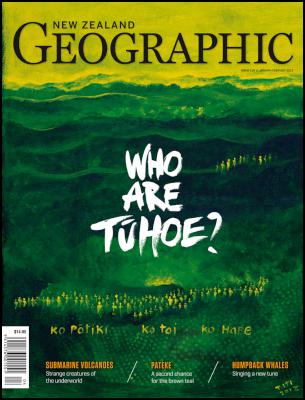Tame Iti paints cover for NZ Geographic, from behind bars
Tame Iti paints cover for New Zealand
Geographic, from behind bars
As Tuhoe’s settlement with the Crown draws near, New Zealand Geographic is running a 40-page feature on the iwi, and commissioned veteran activist Tame Iti to produce the cover art.
Canvases and art materials were delivered to Waikeria Prison, where Tame Iti was serving a sentence for possession of firearms, and the veteran activist put brush to canvas to summon the voice of Tuhoe, dispossessed of their land for 150 years. The cover was Iti’s contribution to a 40-page feature on the iwi in New Zealand Geographic, written by Canon Feature Writer of the Year Kennedy Warne and shot over 18 months by photojournalist Peter James Quinn.

The painting reproduced on the cover depicts the rugged landscape of Te Urewera, hills surrounded by mist and ghostly figures upon the land, with the subtle glow of te ahi kaa, the long-burning fires of occupation. Underneath, the words Ko Potiki, ko Toi, ko Hape—I am Potiki, I am Toi, I am Hape—refers to the three ancestors from whom all Tuhoe descend, Iti’s own answer to the question ‘Who are Tuhoe?’ posed by the cover line.
“This work is a validation: Of the whakapapa, the responsibility and the future that Tuhoe have with Te Uruwera,” says Iti. “The figures show how the people have become entwined with the landscape and mist, how their relationship to Te Waonui a Tane [the great forest of Tane] allows them to assert their mana motuhake.”
Signing of the Deed of Settlement with the Crown is an historic turning point for Tuhoe, who have maintained that the national park should be returned to their control and that they should be able to manage their affairs autonomously—reinstating mana motuhake, or self determination.
This has been Tame Iti’s chief grievance as well, his protestations often leading to conflict with authorities, most recently to allegations of terrorism and convictions on firearms charges.
“Tame Iti knows the power of a controversial statement, he knows how to get attention, and he knows and lives in the long legacy of generations of Tuhoe dispossessed of their land and autonomy,” writes New Zealand Geographic editor James Frankham in his editorial, “And he knows we all tend to judge a book by its cover, so who better to create this one?”
But as Iti builds a case seeking exoneration in the Supreme Court, the ultimate outcome for his wider cause of mana motuhake is due to be signed by Tuhoe’s governing board early next year.
Reading the Waitangi Tribunal report is “an illusion shattering experience,” writes Kennedy Warne in the feature story. “It is not just a catalogue of unjust acts by successive administrations that bursts the illusion of fairness, but the calculated intent to destroy.”
And yet Tuhoe were not destroyed, and are alone among iwi in making self-determination a non-negotiable component of their Treaty claim.
Iti’s image is also reflected in the words of Tuhoe spokesman Tamati Kruger, quoted extensively in the story. “We are this land, and we are the face of this land. Wherever those mountains come from, that’s where we come from. Wherever the mist emerges from and disappears to, that’s where we come from,” he says. “Our self image, as well as our values, is part and parcel of this place. And this is something that Tuhoe people have decided they must not give up.”
“For 150 years, Tuhoe has felt suffocated by the second-hand smoke of European dominance,” writes Warne. “For Tuhoe, mana motuhake represents the pure oxygen of freedom.”
The January/February 2013 issue of New Zealand Geographic, featuring a cover by Tame Iti and 40-page story on Tuhoe is on sale in bookshops and supermarkets from Monday 17 December.
>>


 NZCTU: Govt Vocational Education Reforms Will Cause Massive Disruption
NZCTU: Govt Vocational Education Reforms Will Cause Massive Disruption NZ Liberation Museum - Te Arawhata: Anzac Day Commemorations In France To Remember All New Zealand Soldiers
NZ Liberation Museum - Te Arawhata: Anzac Day Commemorations In France To Remember All New Zealand Soldiers Royal Commission Covid-19 Lessons Learned: We Want To Hear From As Many People As Possible, Says COVID-19 Inquiry Chair
Royal Commission Covid-19 Lessons Learned: We Want To Hear From As Many People As Possible, Says COVID-19 Inquiry Chair My ECE: Parents Reject ECE Deregulation - 'Children’s Safety Is Not Optional'
My ECE: Parents Reject ECE Deregulation - 'Children’s Safety Is Not Optional' TOI: TOI Pays Tribute To ANZACs With Raw And Reflective New Waiata, ‘Lest We Forget’
TOI: TOI Pays Tribute To ANZACs With Raw And Reflective New Waiata, ‘Lest We Forget’ FromThePit: FromThePit 2025 - New Zealand Music Photography Exhibition Returns To Celebrate Local Talent In NZ Music Month
FromThePit: FromThePit 2025 - New Zealand Music Photography Exhibition Returns To Celebrate Local Talent In NZ Music Month